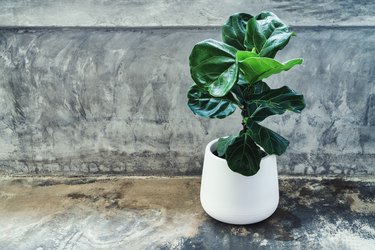
Humans can stand upright, in defiance of gravity, because we have both a rigid skeleton and a complex system of muscles, tendons and ligaments to maneuver it into a vertical position. Plants don't have any of those things, but most of them still find ways to stand up. Whether it's a tiny blade of grass or a massive redwood tree, plants have two main strategies for going vertical. Both of them derive from the plants' cell structure, which differs from the structure of animal cells.
Plant Cell Structure
Video of the Day
Cells are the basic building blocks of all living organisms. Each cell contains a number of structures called organelles, each with its own specific purpose (you could think of them as being like the chips on a circuit board). Most have a nucleus, for example, a sort of "headquarters" where the organism's DNA does its organizing work. The mitochondrion is the cell's equivalent of a generating station, Ribosomes produce proteins, the lysosome makes enzymes, the watery cytoplasm gives the other organelles a supportive environment to work within, and the outer cell membrane holds them all together.
Video of the Day
Plants add a couple of things to that basic recipe. Most have organelles called chloroplasts, which give them their green color and their ability to turn sunlight into nutrients. They also have vacuoles, which can store water and waste products. Finally, and most importantly for upright plant growth, they have an additional structure called a cell wall outside of the cell's membrane.
The Cell Walls of Plants
Cell membranes are made up of fats and proteins, but cell walls are different. They're made from relatively tough carbohydrates called cellulose and lignin. Cellulose is the same stuff you'd know as "fiber" on a nutritional label: we can eat it, but can't digest it. Lignin is even more fibrous, and in fact any plant-based fiber you've ever worn – cotton, hemp, linen – consists mostly of lignin. The more lignin there is in the cell walls, the woodier the plant is.
Plants with high levels of lignin in their cell walls are sturdy enough to stand on their own, even when they're dead and dry. Trees and bushes are the most obvious examples of this, and so are the dried-up stalks and stems of plants you see in midwinter in your garden (or a meadow). Plants with less lignin use a different strategy, and stand up straight with the help of water.
Plants Staying Upright With Water
Remember those water-storage organelles called vacuoles that are part of a plant's cell structure? They also play a role in helping plants stand upright. As the plant takes up water through its roots by way of its vascular system (kind of like the veins in animals), the vacuoles store that water inside the cells. That water presses against the cell wall and firms it up, in much the same way that air pressure turns a floppy piece of leather into a football or soccer ball. That pressure, called turgor – a great word, but not easy to drop into casual conversation – is what helps keep non-woody plants upright.
This is why, when you've forgotten to water your plants or drought overtakes your garden, the plants show it by becoming soft, droopy and floppy. They just don't have enough turgor pressure to stand up straight and tall anymore, until they're watered.
Plant Cell Structure Examples
The nearest garden (or your kitchen) can provide several examples of both strategies. Delicate lettuces clearly rely on turgor: by mid-summer, just a few hours without adequate watering can make them wilt. Herbs such as thyme or rosemary are adapted to lower-water scenarios, with woody stems that hold them upright even when they're dry.
Many plants use both turgor and lignin to stand upright. Broccoli is a good example. The outer skin of the broccoli stem is tough and leathery, and helps hold the plant upright even when it's thirsty, but if you peel it away the inner flesh is crunchy and juicy. That's the result of turgor pressure within the cells.